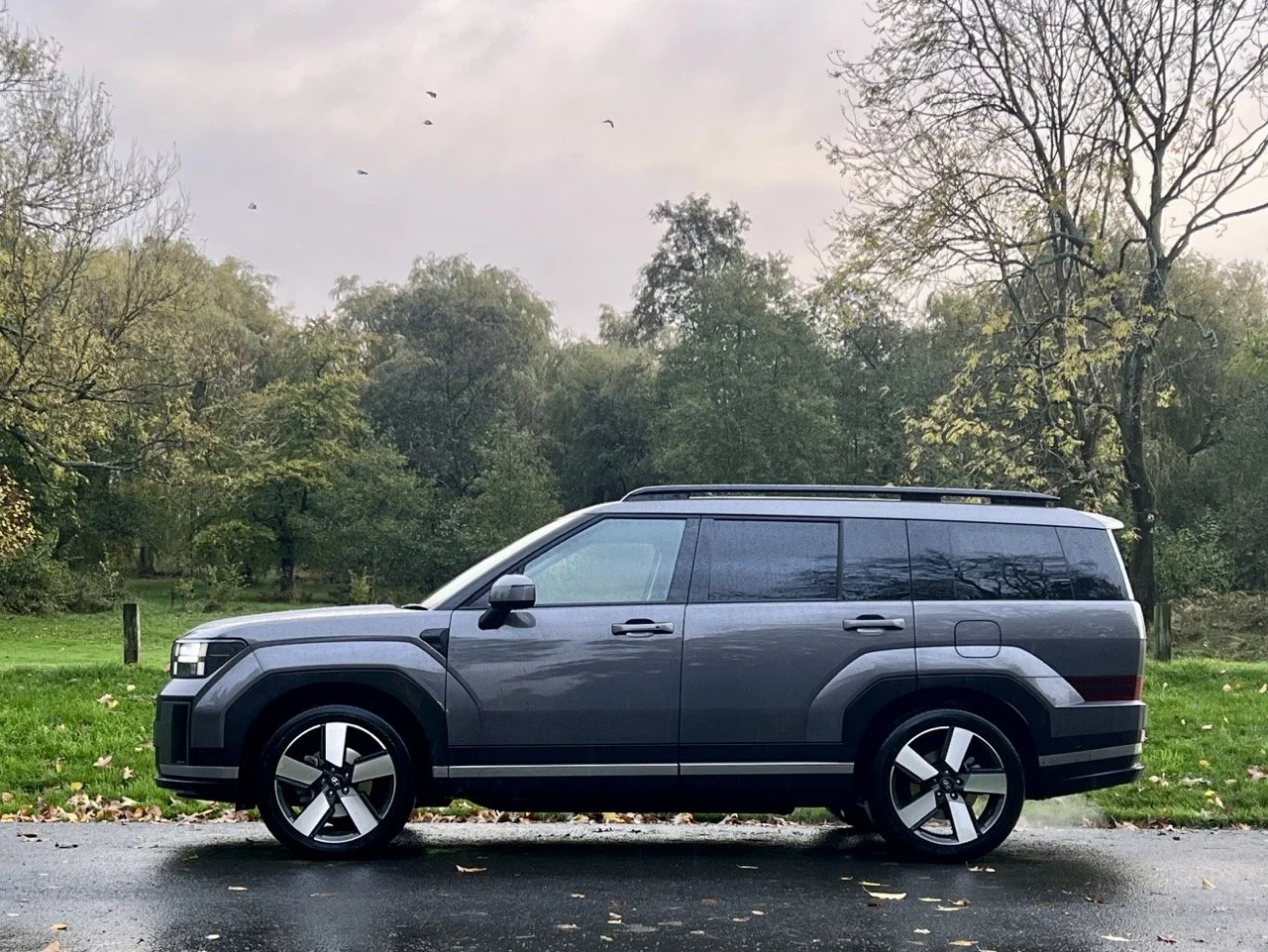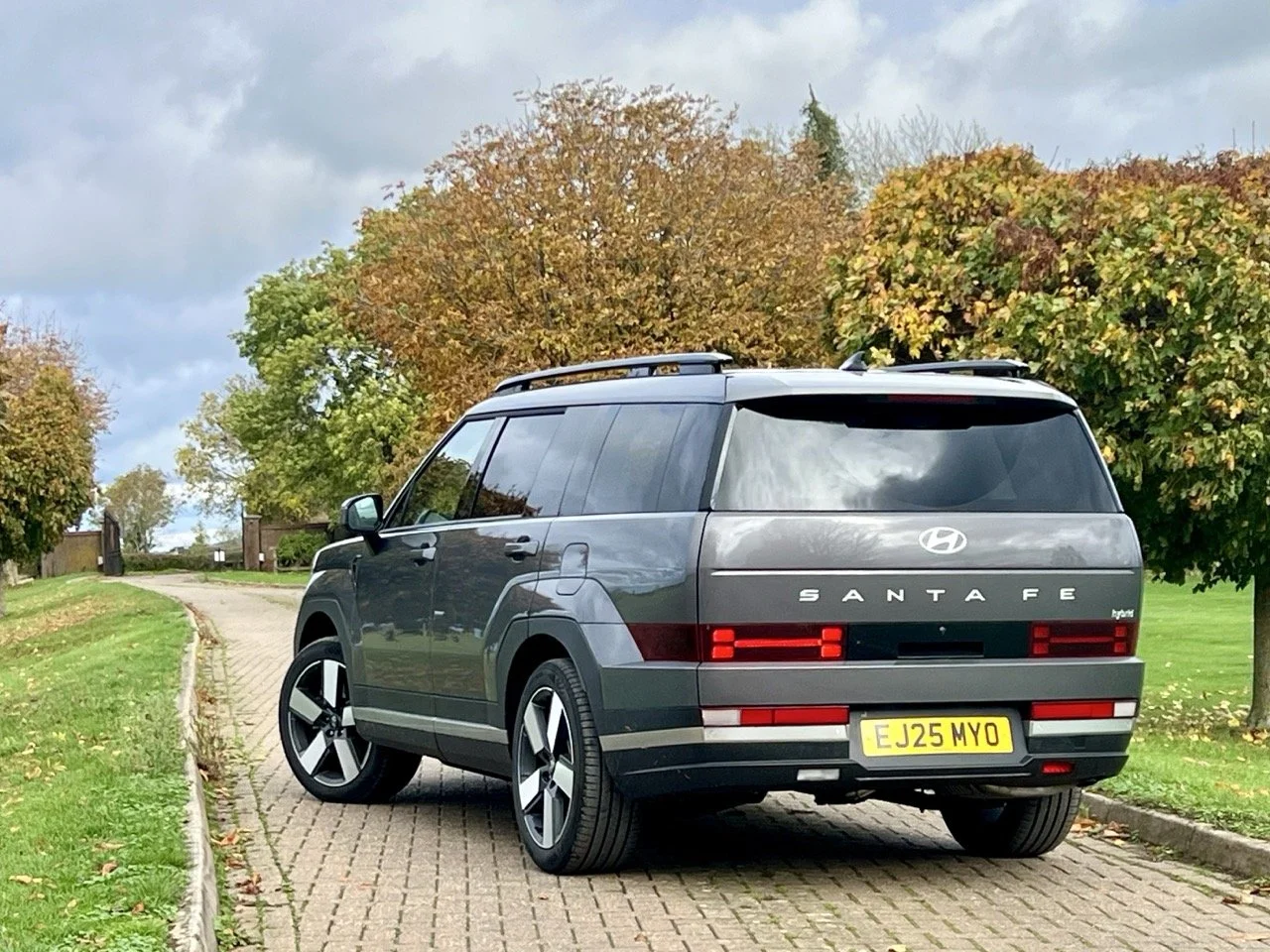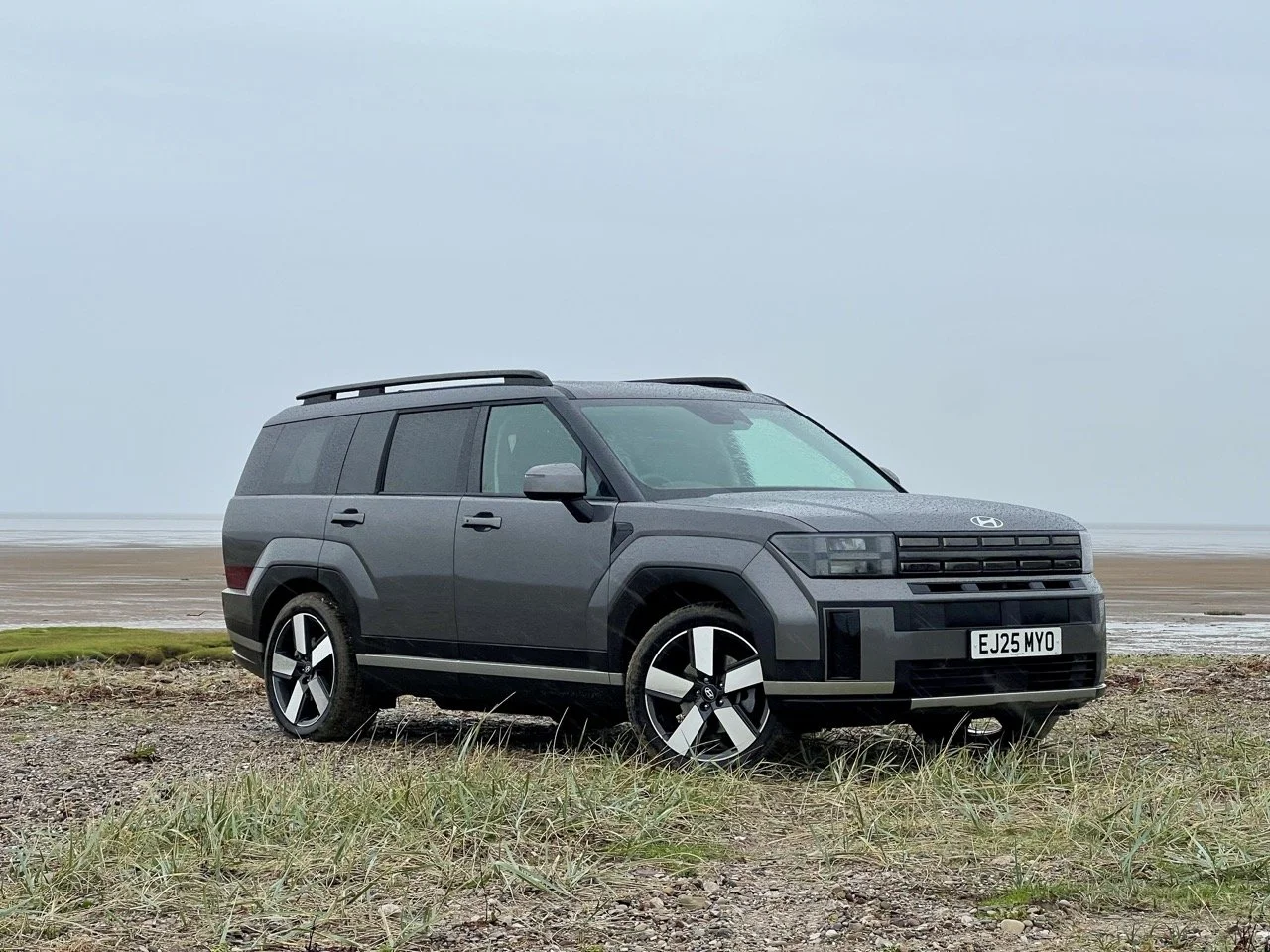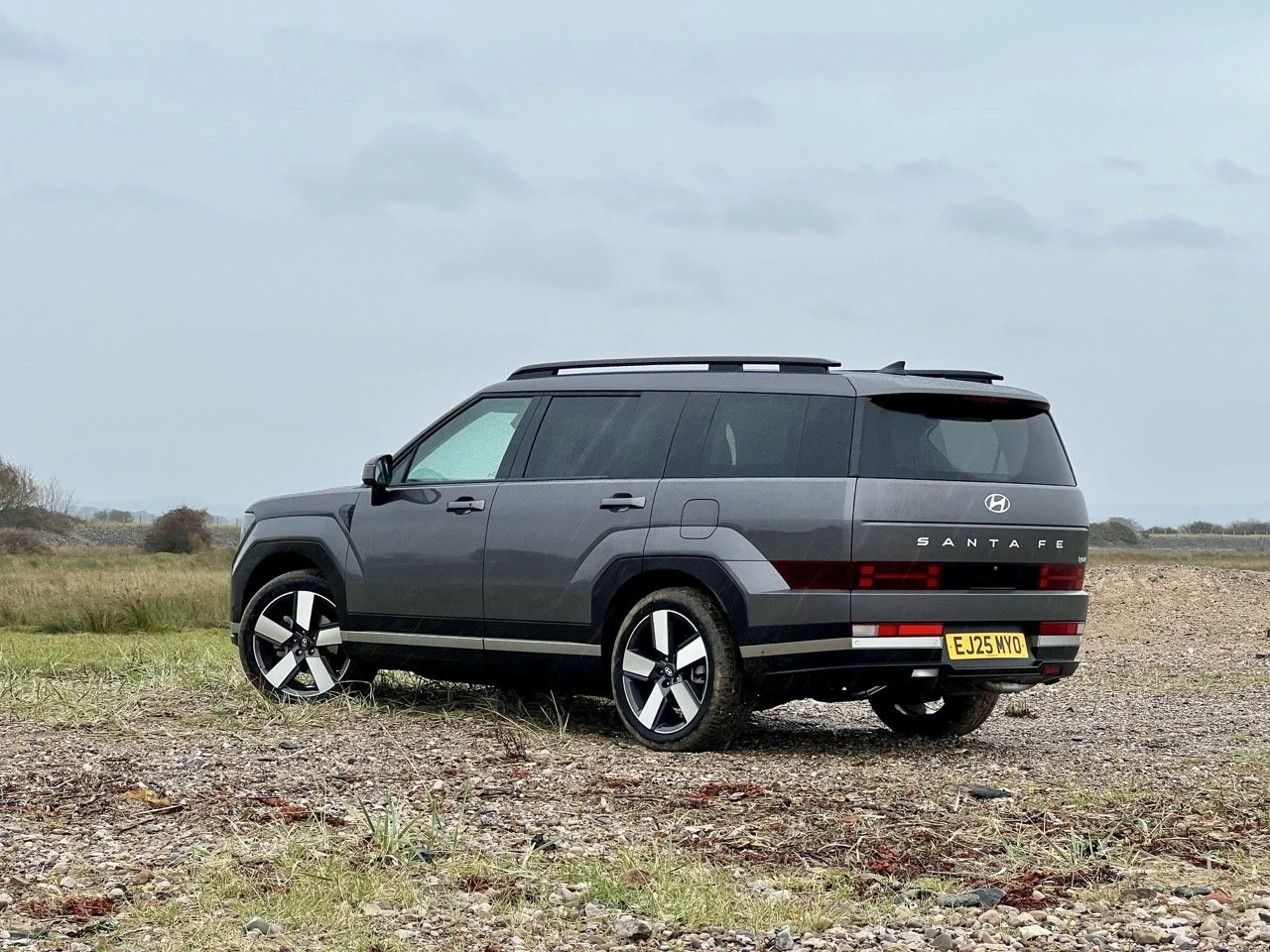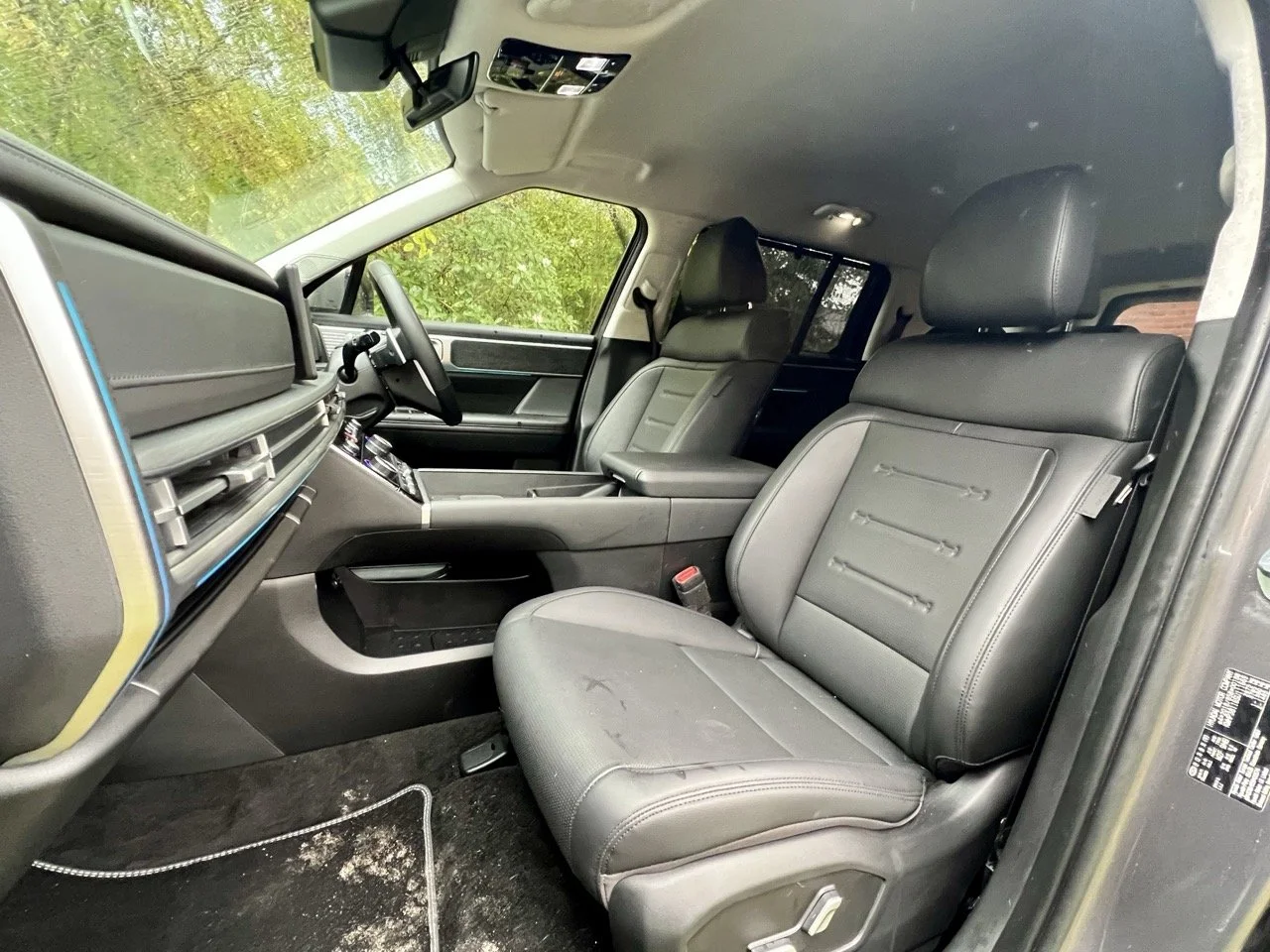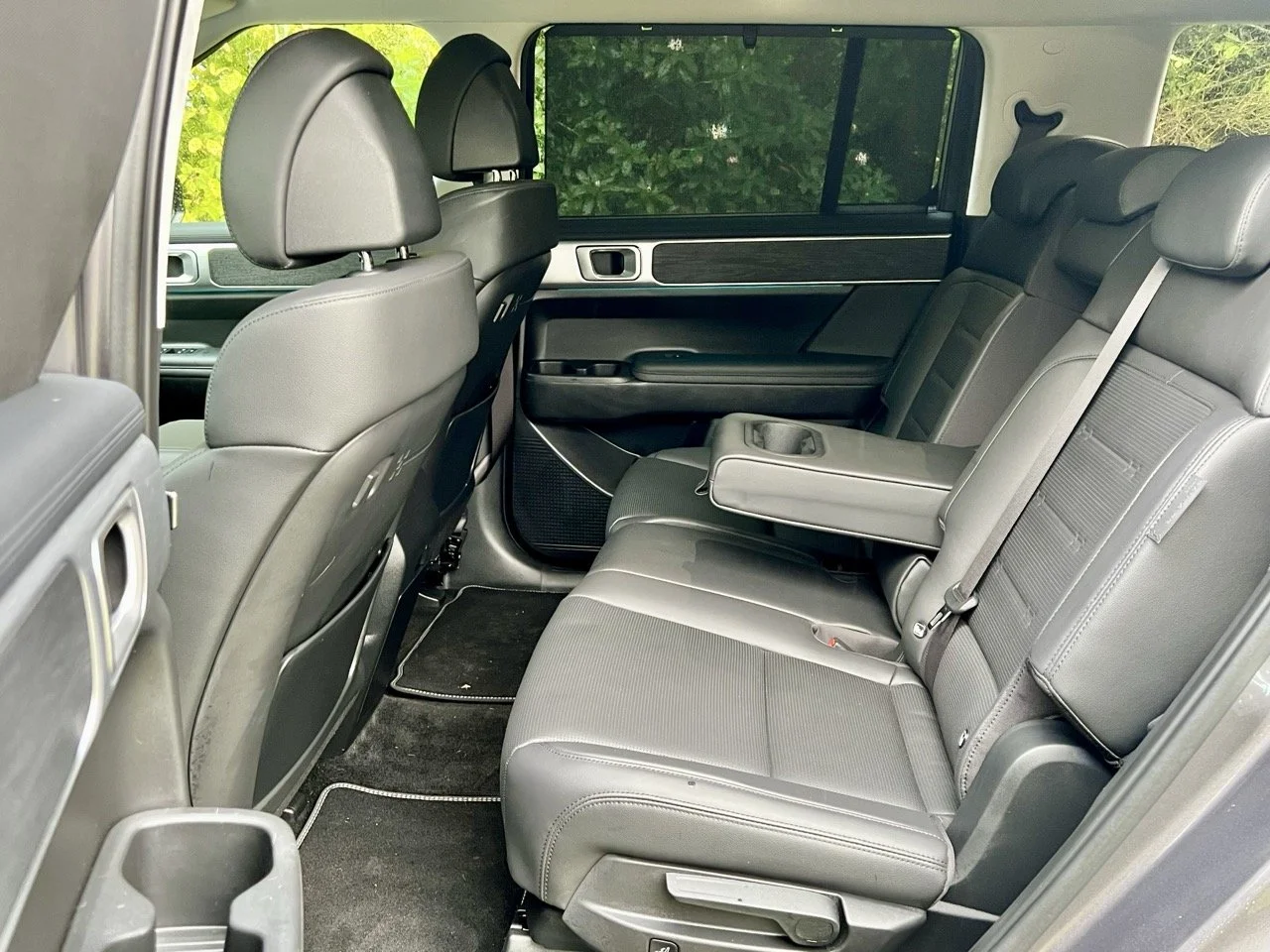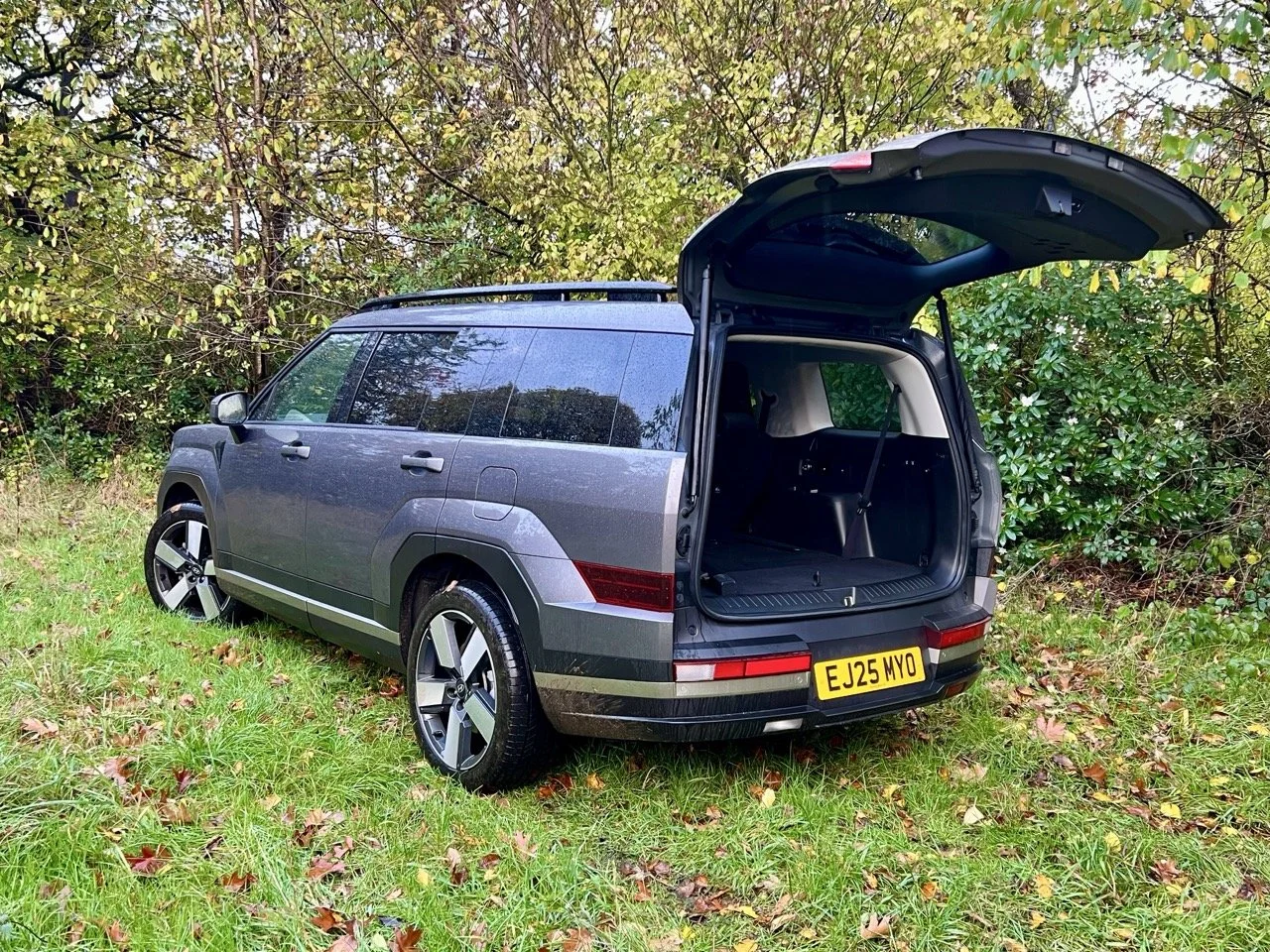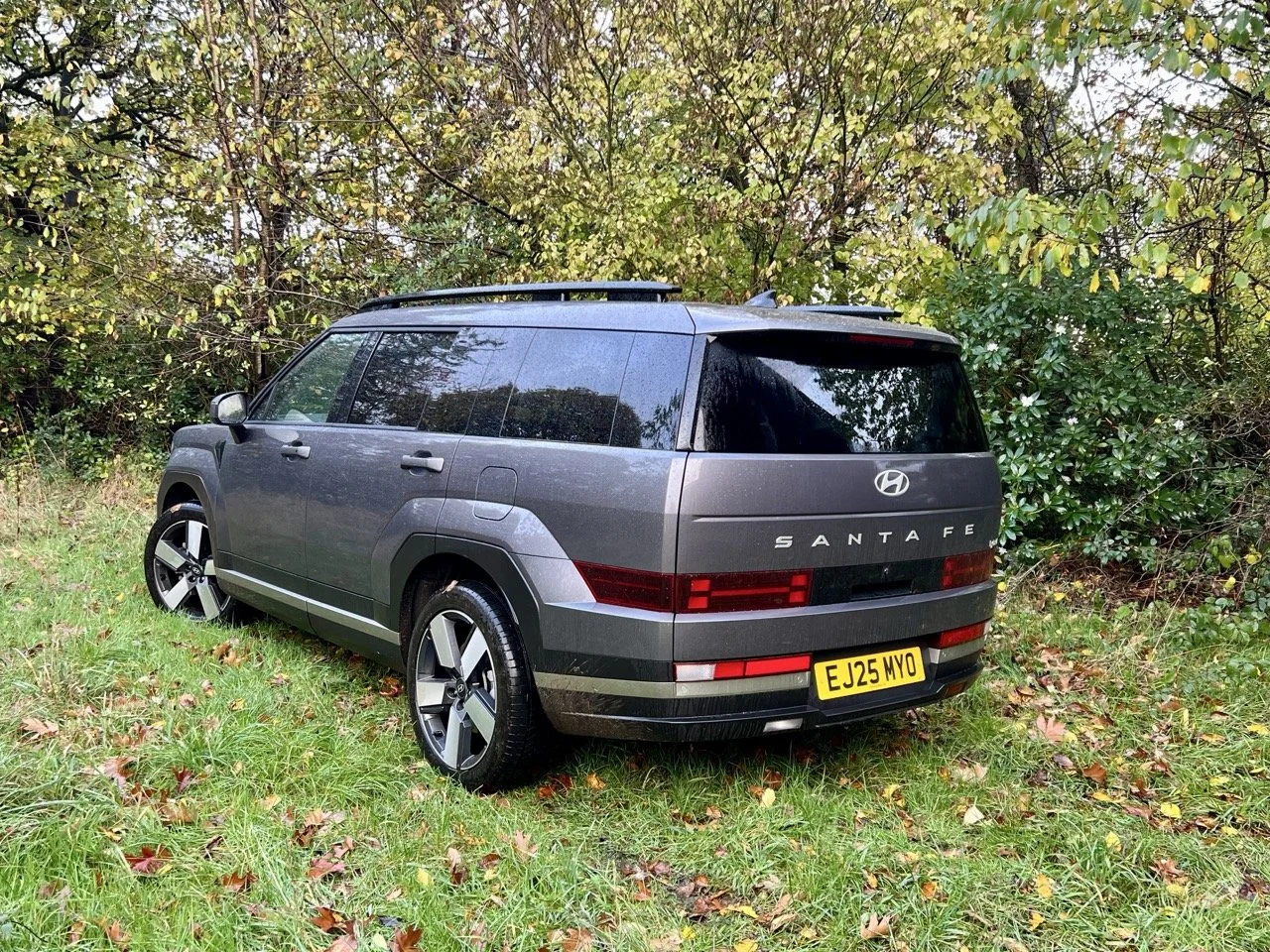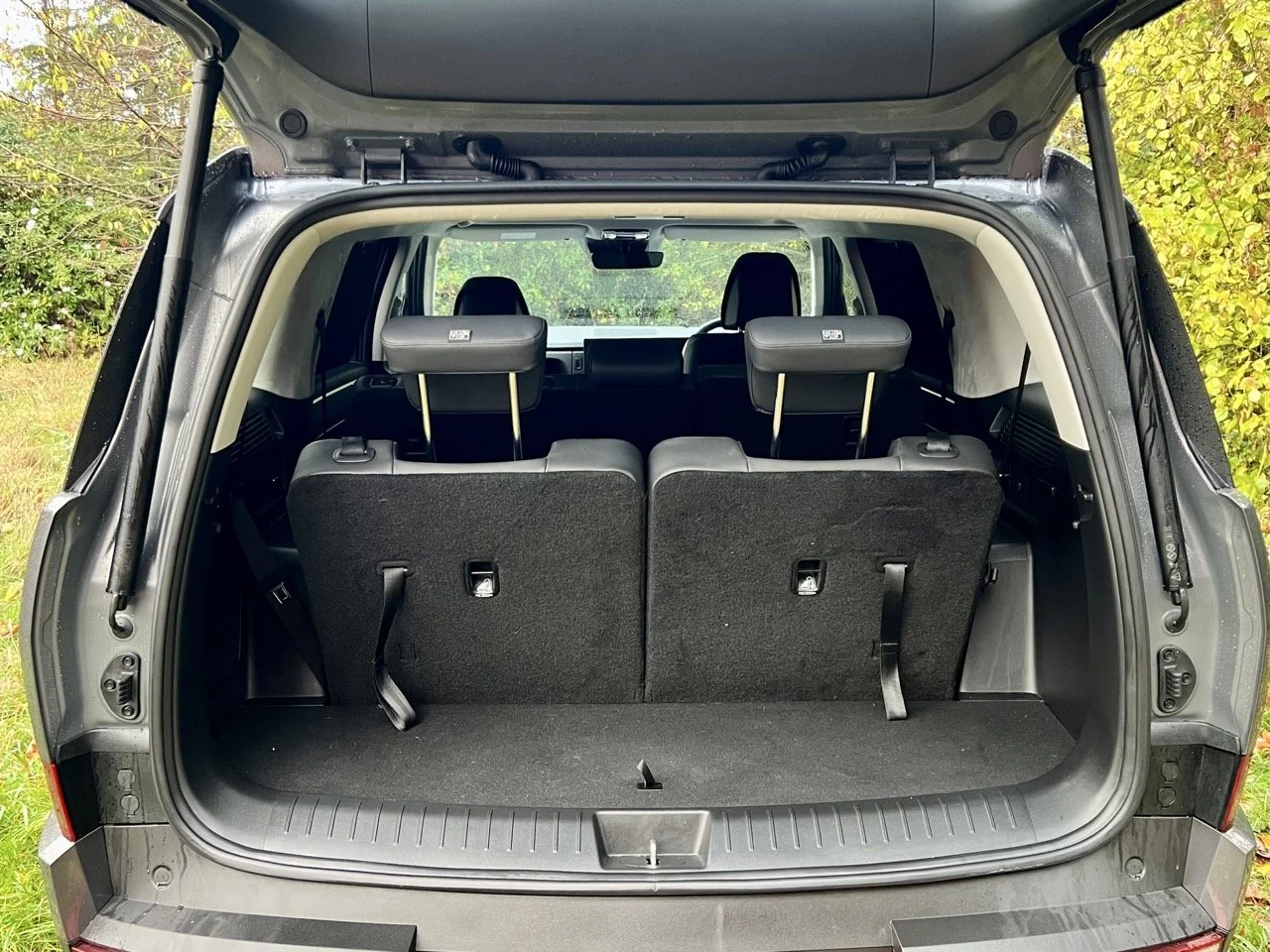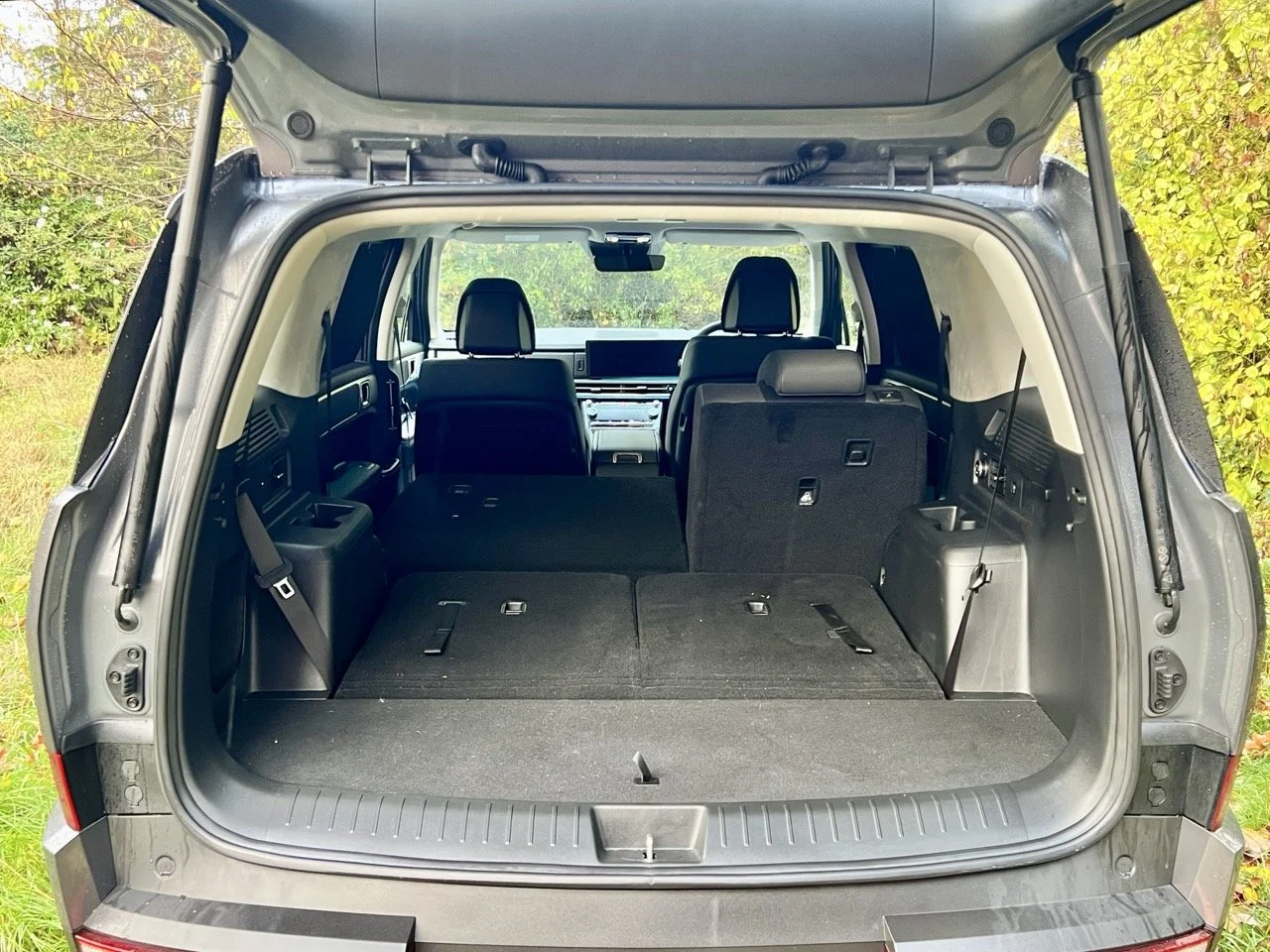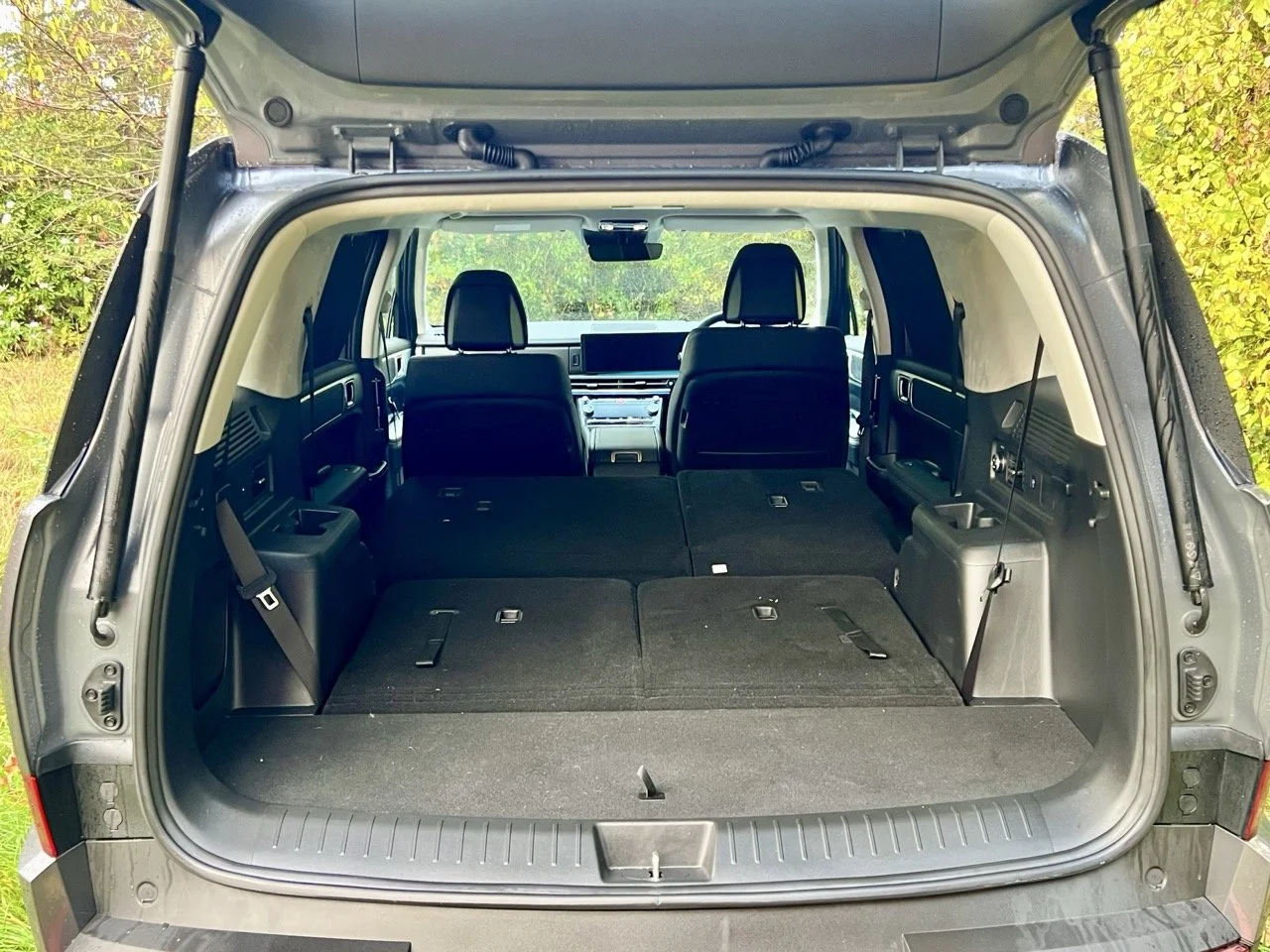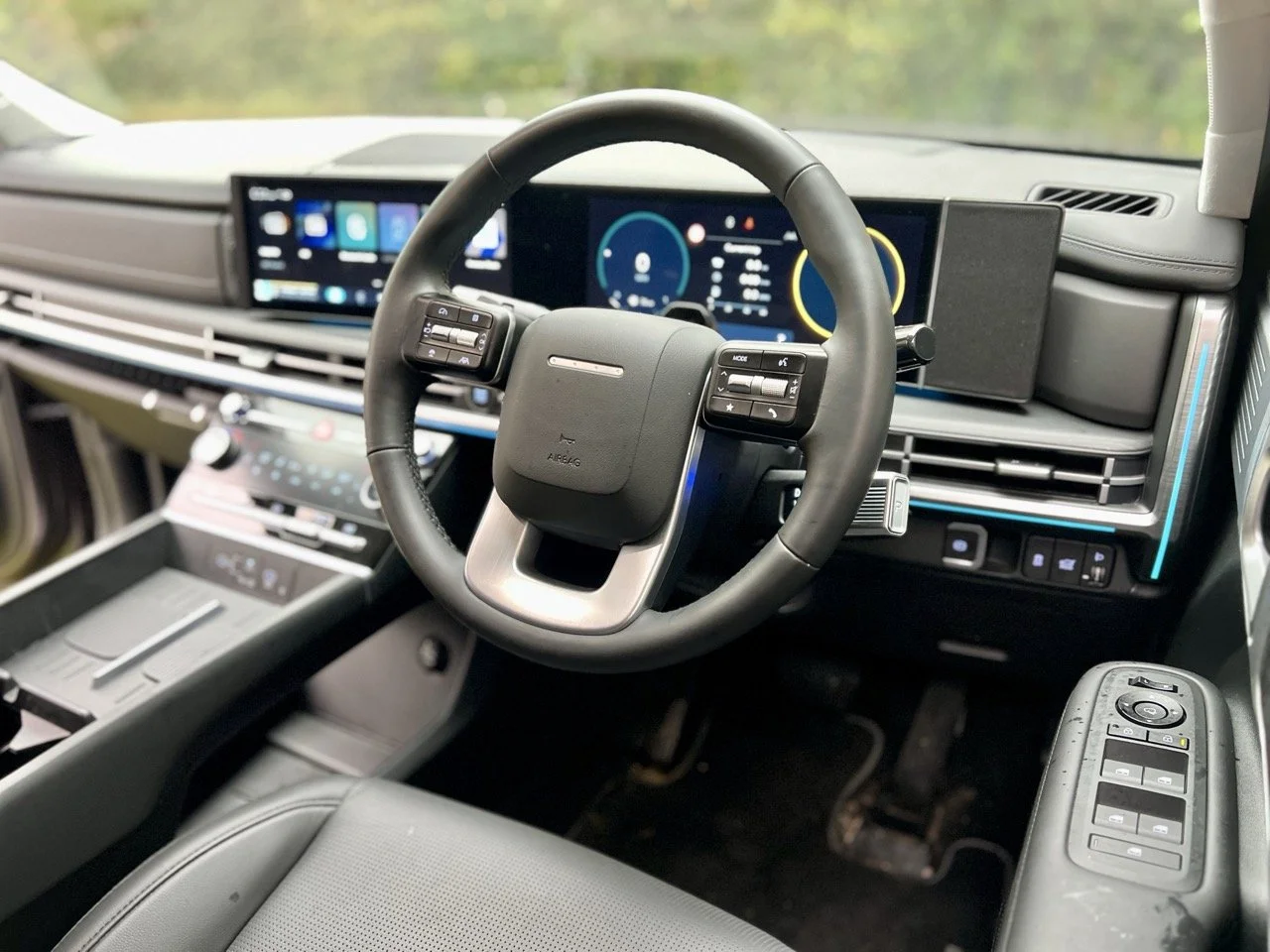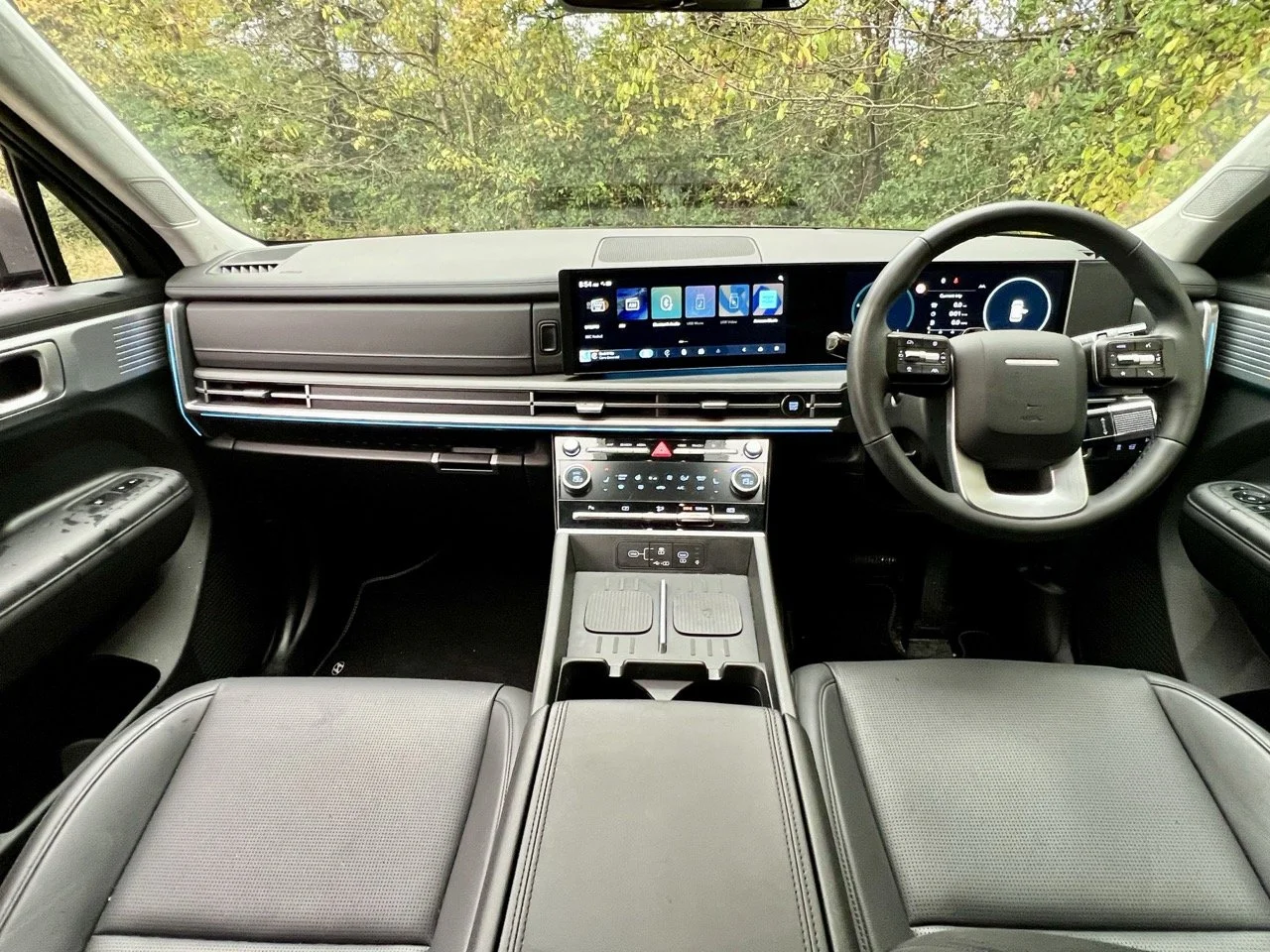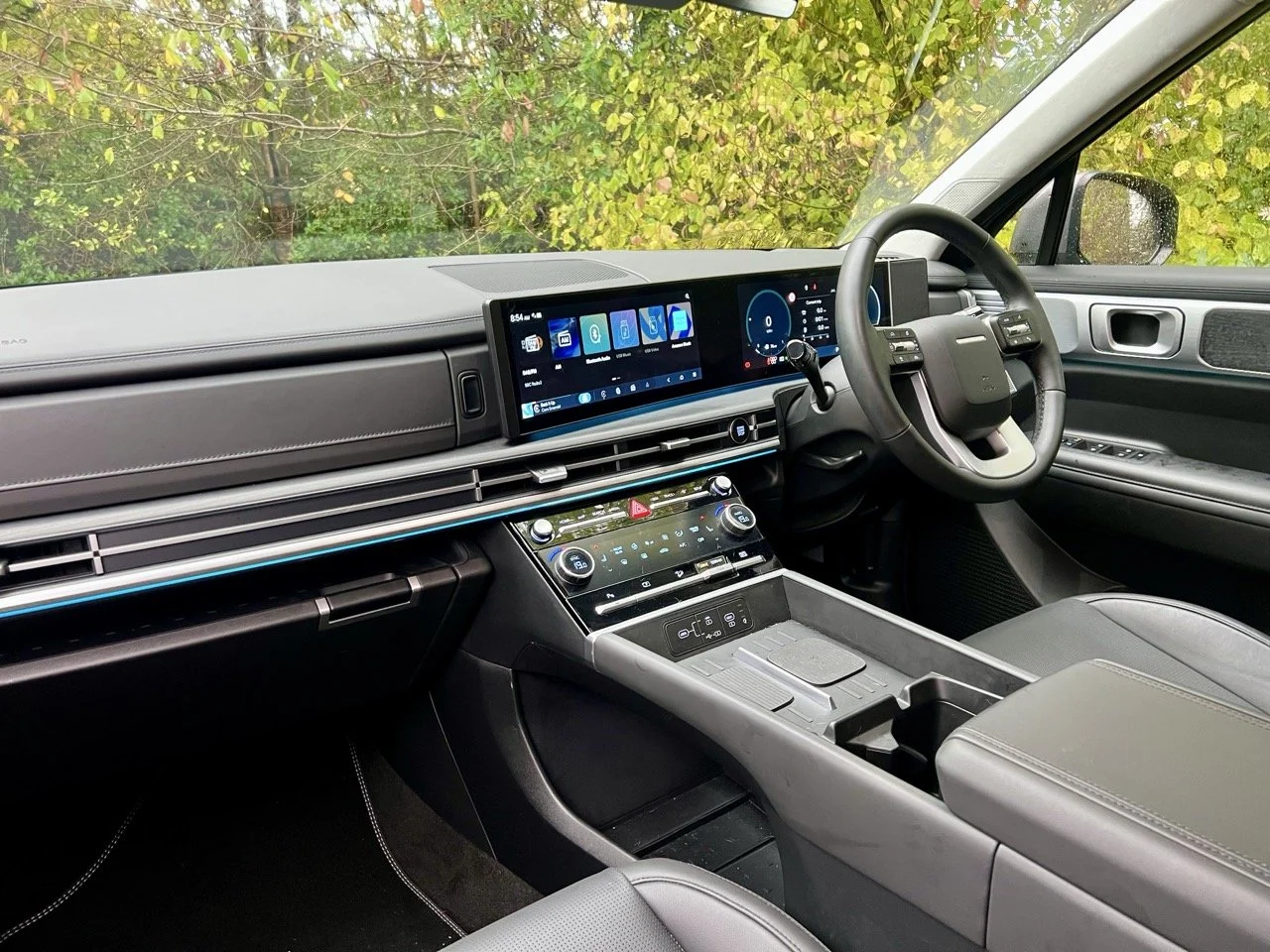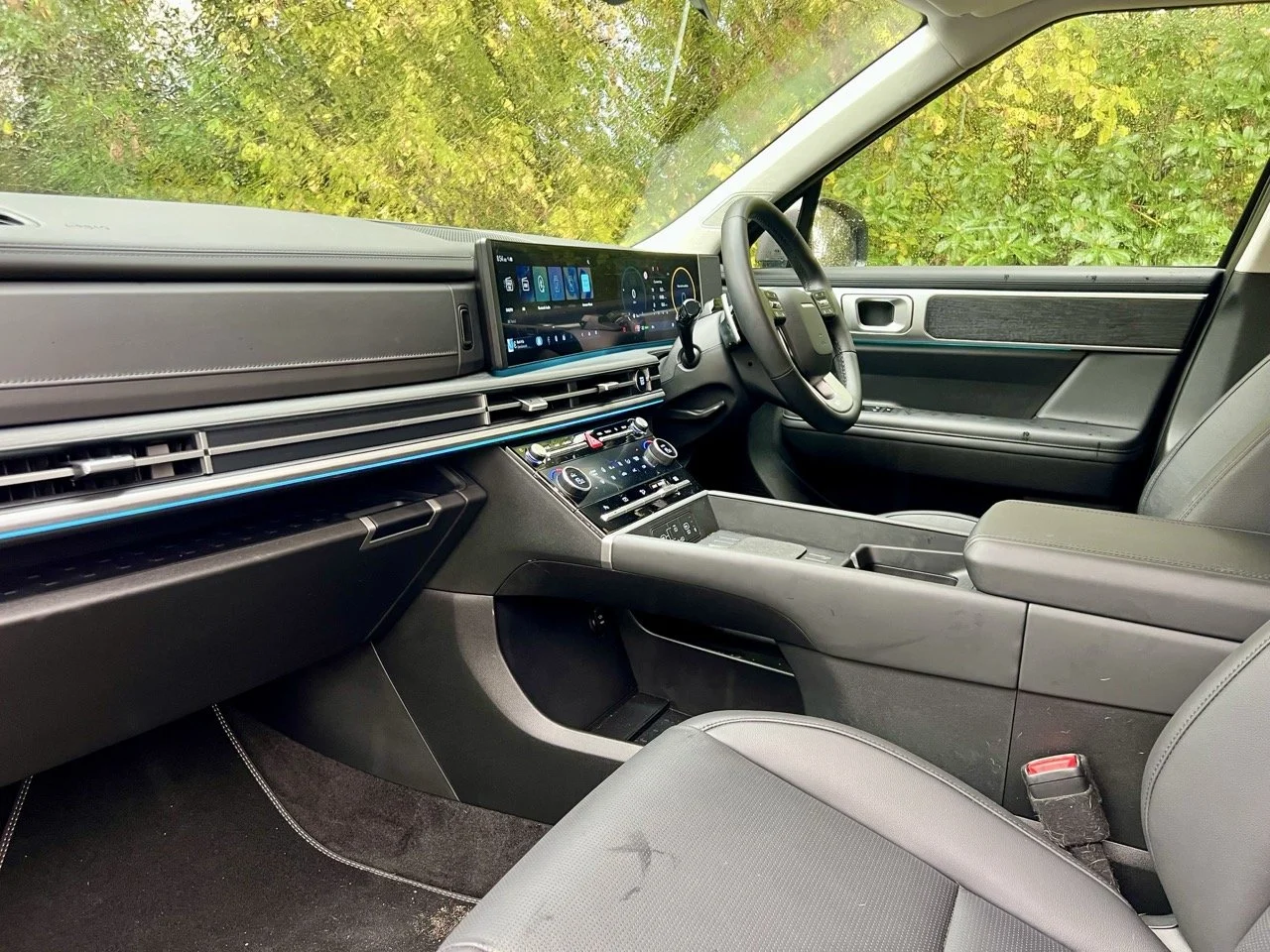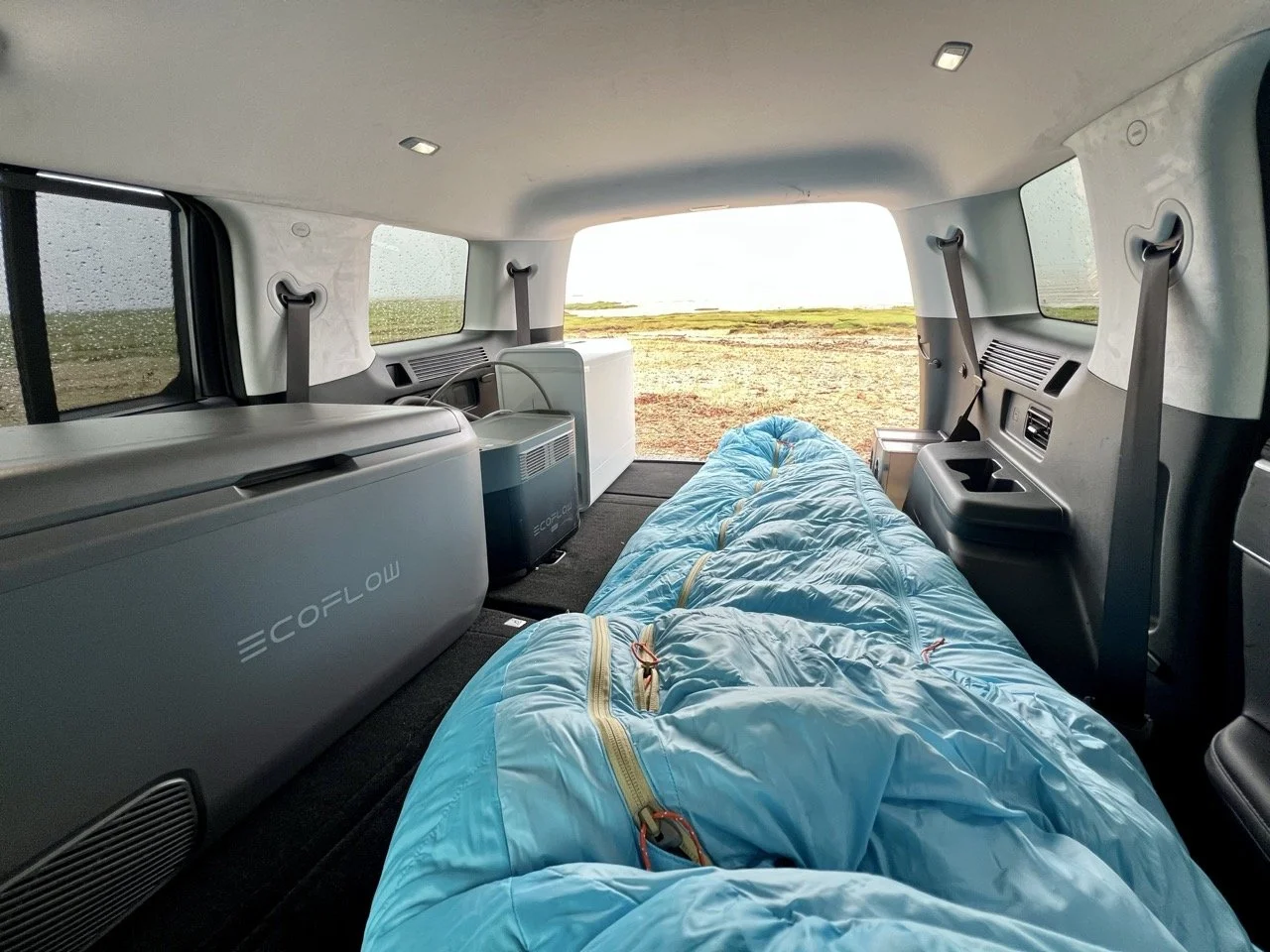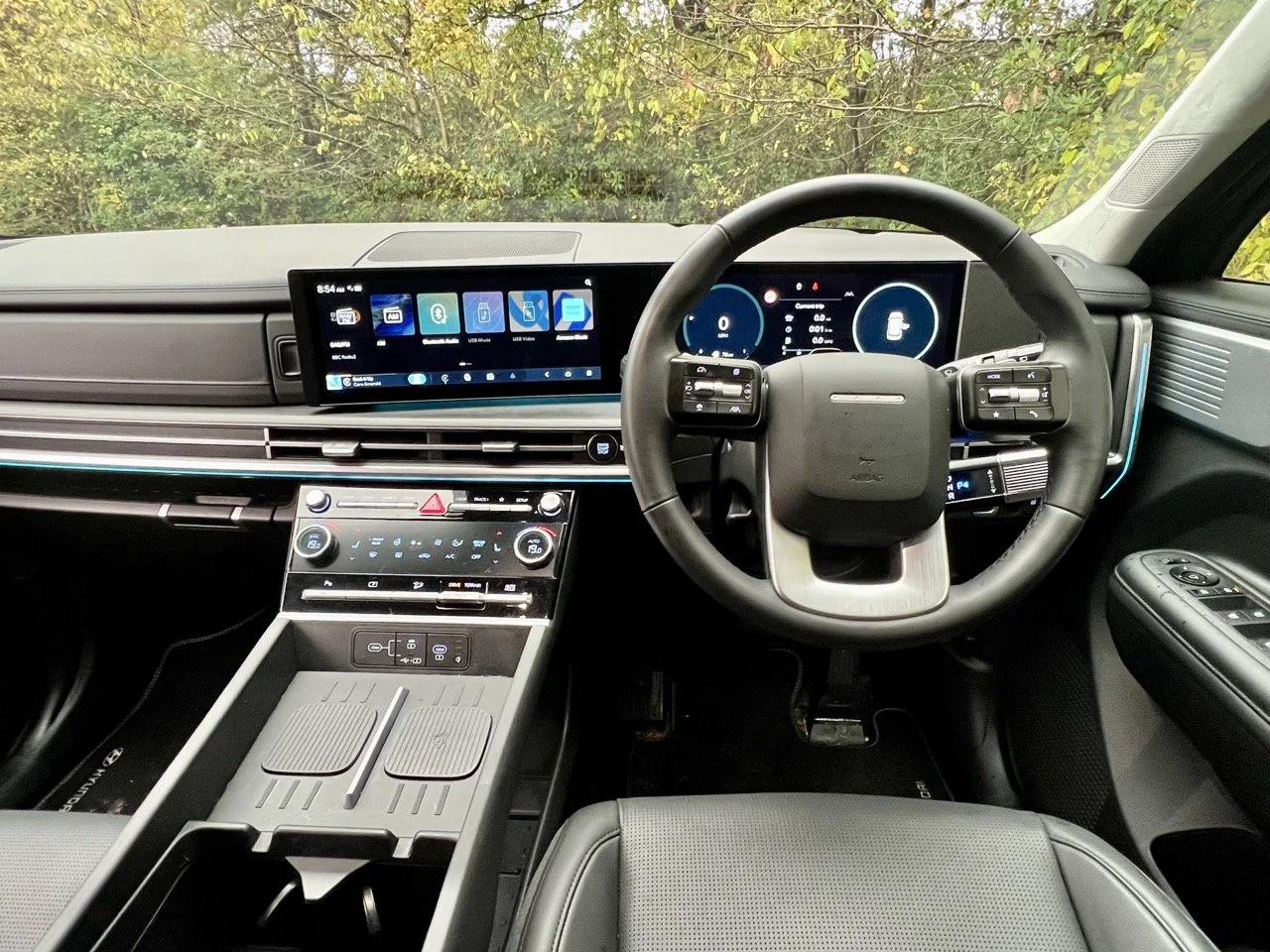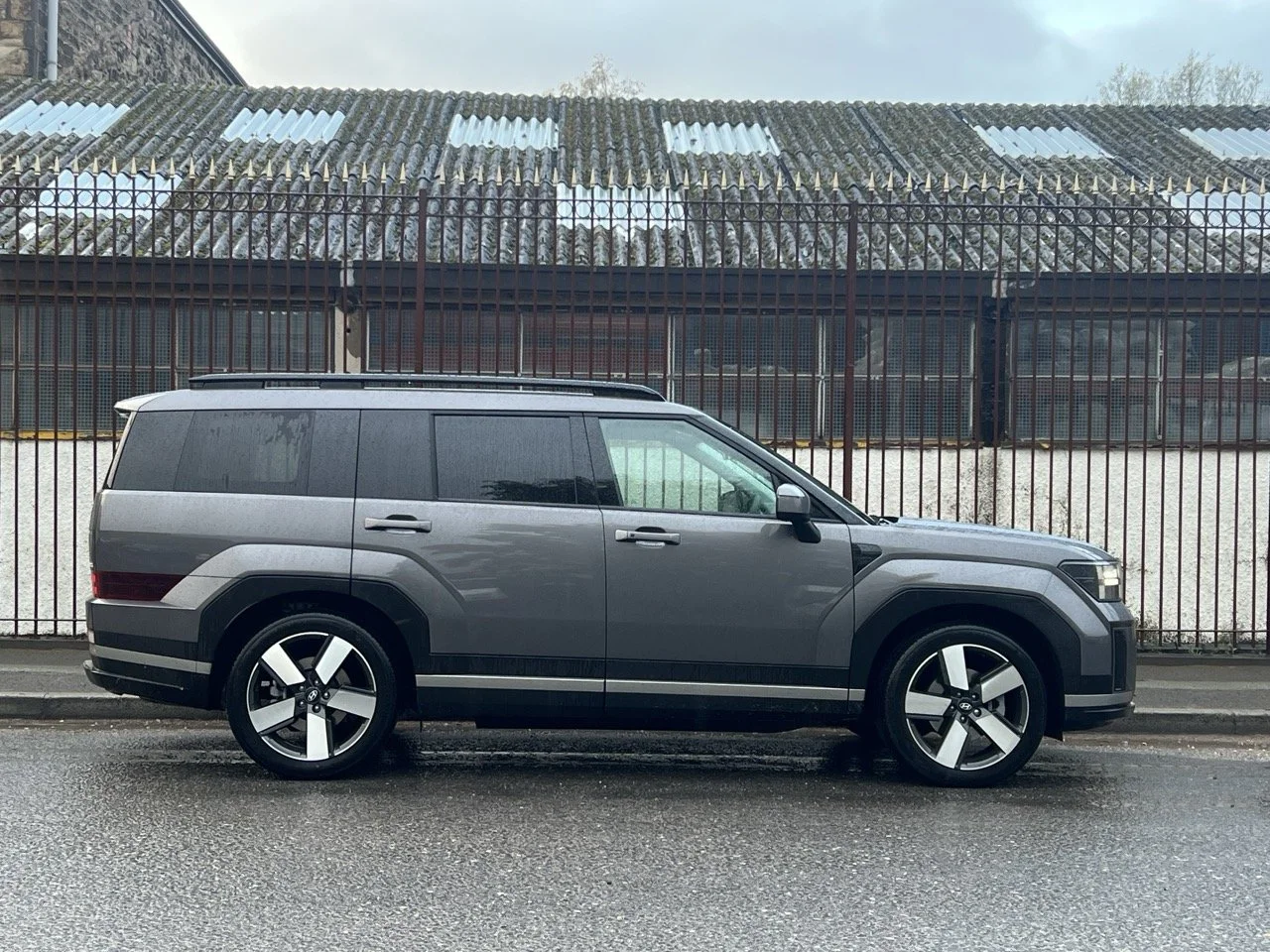Review: 2025 Hyundai Santa Fe
First Impressions: Did Someone Leave a Defender in the Wash?
Right, settle down, put the kettle on, because we need to talk about the 2025 Hyundai Santa Fe. If you’re anything like me, your initial sighting of this behemoth—be it on a rain-slicked bypass or, perhaps, on the school run will have involved a double-take. "Is that a Land Rover?" you'll have thought, followed swiftly by, "No, wait... it looks like a Lego model of a Land Rover designed by someone who really loves the letter H.”
The old Santa Fe? Bless its cotton socks, it was perfectly fine. A bit beige, a bit anonymous, like a nice pair of sensible slippers. This new one? It’s had a complete personality transplant, swapping its curves for a ruler and a hefty dose of attitude. It’s square, it’s chunky, and it's got a back end that looks like it was designed specifically for tailgating a Defender 110 just to wind up the owner.
The H-shaped LED lights, front and rear, are a brilliant, bold piece of corporate branding that ensures you know exactly what you’re looking at, even if your brain is still telling you it must have wandered off a film set.
So, what exactly is this square-jawed newcomer, specifically the Premium 1.6-litre 4WD Hybrid we’ve got our hands on?
In Hyundai’s pecking order, the Santa Fe is the daddy - the flagship SUV, sitting above the Tucson and the Kona. It's the one that takes on the proper big lads of the seven-seat segment. But the most interesting part is who its siblings are.
Underneath all that angular new bodywork, it shares its core platform and hybrid gubbins with the excellent Kia Sorento, a vehicle we're fond of here at The Mud Life. However, where the Sorento remains slick and slightly more aerodynamic, the Santa Fe has grown upwards and outwards, aiming not just for the Koreans and Skodas of the world, but throwing a proper northern punch at the likes of the Volvo XC90 and even those aforementioned Land Rovers. Hyundai is no longer content to be the budget option; this is the brand going properly upmarket, offering Range Rover size and practicality for considerably less financial pain.
By 'eck, they’ve made a statement. Now let’s see if it holds up when the going gets less than perfect.
On the Tarmac: Cruising Comfort and the 1.6-Litre Question
Let's be honest, even in a 4x4 magazine, 95% of its life will be spent on A-roads, motorways, and battling the treacherous car park at Tesco. So, how does the new Santa Fe cope with the drudgery?
The short answer is: brilliantly, provided you’re not in a tearing hurry.
Hyundai has clearly prioritised comfort, which is a proper job for a large family vehicle. The suspension is set up on the soft side, meaning it glides over the usual UK road imperfections - those potholes that look like they were made by a meteorite, with a respectable lack of fuss. It pitches and rolls a bit when you throw it into a roundabout like a hooligan, but it quickly gathers its composure. For long motorway hauls, it’s remarkably quiet and feels exactly what it is: a substantial, planted cruiser. After a boring 3-hour drive to Milton Keynes, the steering was light and accurate enough to make wrestling this big box into a parallel parking spot far less of a chore than its size suggests.
However, we need to address the elephant in the boot: the 1.6-litre Hybrid engine. Now, 1.6 litres in a car this big sounds like bringing a teaspoon to a knife fight. With the combined effort of the turbocharged petrol engine and the electric motor, you get a healthy-sounding 212bhp (or thereabouts), which is ample for most situations. But when you ask it to shift - say, when you’re attempting a bold overtake on a damp A-road, or you’ve got the full complement of seven people and a week's worth of camping gear, that small engine makes itself heard. It gets a bit coarse, a touch vocal, and the six-speed automatic gearbox takes its sweet time deciding what to do. It’s not slow, exactly, but it’s definitely "leisurely." Performance metrics are closer to an old-school four-cylinder diesel, which, funnily enough, is what a lot of us are used to, but without the satisfying low-down torque grunt.
As for fuel economy, the figures suggest you might nudge 40mpg, but if you’re driving it like a true northerner (i.e., making maximum progress), expect those figures to hover more realistically in the mid-to-high 30s. It’s efficient enough, especially around town where the hybrid system can pootle about silently for short bursts, but it’s no miracle worker.
The Mud Life Test: Where the Tarmac Ends
Right, now for the important bit. This is The Mud Life, not The Dual Carriageway Enthusiast. How does a posh, Korean, seven-seat hybrid with questionable ground clearance fare when faced with a bit of proper grit?
The reality check is swift. While the styling strongly suggests you should be crossing the Serengeti, the Santa Fe is fundamentally a road-biased SUV. It's built for comfort, not for conquering the Khyber Pass.
Our Premium model comes with Hyundai’s HTRAC All-Wheel Drive system. This is a smart setup that continually adjusts the torque split between the axles, giving you better grip when conditions go a bit pear-shaped. Crucially, it comes equipped with the “Terrain Mode Select.” You get settings for Snow, Sand, and Mud. These modes don't magically turn it into a tractor, but they fettle the throttle response, the gear shifts, and, most importantly, the traction control system to give you the best possible chance of getting out of a sticky situation without having to call a mate with a proper winch.
The main limiting factor here is the ground clearance. At around 177mm, it’s respectable for a family bus, but it's nothing that will make a Defender owner tremble with fear. It’s high enough to manage rutted farm tracks, get you across a sodden campsite field with ease, and deal with the truly epic speed bumps in modern urban estates. But attempting anything involving significant rock crawling or deep ruts will end with an expensive thud to the underbody.
As you can see below, a beach car park was all I was about to tackle.
The verdict for our readership?
It’s a supremely competent soft-roader. It's the ideal vehicle for the lifestyle 4x4 owner: the one who genuinely needs 4WD confidence in winter, to tow a caravan to the Yorkshire Dales, or who regularly attends muddy agricultural shows. It looks the part, it has the tech to get you through the sludge, but it hasn’t quite got the legs to be a full-blown explorer. Think of it as a posh welly boot for the family, not a full set of waders for the swamps.
The Inner Sanctum: Comfort, Storage, and the Muddy Dog Question
Step inside the Santa Fe, and the impression of a genuine upmarket charge continues. If the exterior is Lego, the interior is pure Grand Designs. The quality of materials, the intricate design details, and the sheer volume of space put several more expensive rivals to shame. The cabin is airy, thanks to that squared-off roofline, which gives you genuinely incredible headroom.
The comfort for passengers is excellent. The second row is a proper sofa, and the seats slide fore and aft, allowing you to easily balance legroom between the second and third rows.
Ah, the third row. A lot of seven-seaters offer a third row suitable only for small children or very flexible adults you dislike. The Santa Fe is different. That boxy design pays dividends here, giving even row three occupants decent head space. It’s a proper seven-seater, and that is a major selling point for anyone moving serious quantities of people.
Now for the practical stuff, which is vital for The Mud Life readers.
Loading the Tat: This car is a storage champion. Boot space, even in the seven-seat configuration, is enormous when the third row is folded flat - over 600 litres, which will swallow all your camping gear, fishing tackle, or enough garden centre purchases to restart the entire ecosystem. The opening is gargantuan - so wide Hyundai actually refers to it as a "terrace" or "balcony" where you can sit and enjoy the view, out of the rain in you’re up north!
The Muddy Dog Test (Crucial): This is where the Santa Fe scores full marks. The loading lip is low and flat, making it an absolute doddle for a large, wet Labrador to hop in without needing a boost. The sheer width of the tailgate opening is a huge plus for manoeuvring bulky items (or a grumpy dog cage). The wipe-clean nature of many of the plastics and the fact the third-row seats fold flat with a simple electric control located in the boot makes post-adventure clean-up relatively painless. Proper job.
The storage up front is equally bonkers: dual wireless charging pads, a huge open storage tray underneath the floating central console bridge (perfect for a small handbag or a half-eaten Greggs), and even a handy shelf in the dashboard. There’s also a UV-C sterilisation tray for your phone. A bit poncey, perhaps, but useful if you think your phone has picked up some questionable bugs down at the off-road course.
But can I use it as a camper?
Legend has it that on the initial UK launch, the Hyundai PR team decided it would be fun for motoring writers to sleep in the back of their Santa Fes - so I tried the same.
Along one side I loaded my Ecoflow Glacier Classic fridge, Loch Capsule Solo Dishwasher (reviews coming soon), and my Ecoflow Delta 2 Max to power them both. My sleeping quarters was on the other side. On the other side I lay my sleeping bag.
Do you know what? It was actually quite cosy, especially as the all rear seats fold completely flat - a rarity these days.
Tech, Control, and Pet Peeves
Modern cars often infuriate those of us who prefer to, you know, drive the car, rather than navigate through three sub-menus just to turn the temperature up. This brings us to the tech and, more importantly, the pet peeves that can instantly ruin a good car.
The digital dashboard is a curved glass affair housing twin 12.3” screens for the driver display and the infotainment system. It looks ultra-modern, the graphics are crisp, and it handles wireless Apple CarPlay and Android Auto with aplomb. It’s high-end stuff.
However, many manufacturers insist on burying basic functions - like turning the heating on - deep within the digital trenches. Hyundai, thankfully, has remembered how to make a proper control.
Pet Peeve A: Heater Controls (The Major Win) This is a massive positive. Below the main screen, there is a dedicated climate control panel that features actual rotary dials for temperature adjustment. Hallelujah! No frantic tapping on a glossy screen while you’re barrelling down the M6 in the rain. That said, you do have to prod the screen for fan speed and other primary HVAC functions. So points given, points taken away.
Pet Peeve B: Lane Departure & ADAS (The Minor Grumble) Like all modern vehicles, the Santa Fe is drowning in driver assistance systems (ADAS). Lane Keep Assist (LKA) and Intelligent Speed Limit Assist (ISLA) are usually the biggest offenders, often feeling over-eager. While the physical climate controls are excellent, the ability to quickly and permanently disable some of the more irritating electronic nannies is usually tucked away in a menu.
Thankfully, the button for disabling the Lane Keep Assist (LKA) is situated on the steering wheel, for the rest, you do have to delve into the menus, I’m afraid.
The Mud Life Verdict
So, where does the 2025 Hyundai Santa Fe Premium 1.6 Hybrid 4WD fit in the grand scheme of things?
It’s an absolute game-changer for the brand. This isn't just a new Santa Fe; it's a statement that Hyundai is now operating in the same airspace as true premium seven-seat SUVs. It offers the boxy utility and physical presence of a Discovery or a Defender 110 (if you squint hard enough and stand a mile away), but it delivers it with Korean efficiency and a price tag that won't make your eyes water quite as much.
For the user who needs the space (lots of space), the practicality, the low loading lip for the dog, or a IKEA shop, the ability to pack a small mountain of camping gear, and the peace of mind of a competent 4WD system for muddy fields and wintry blasts, this car ticks a lot of boxes.
Granted, it’s not a true off-road king, and that 1.6-litre engine can sound like it’s struggling to cough up a fiver when pushed hard. But these are minor quibbles when weighed against the overwhelming practicality, the genuinely premium interior, and the massive win of those proper physical heater controls.
The new Santa Fe is a massive, boxy, practical triumph. It’s proof that you don't need a posh badge to get a genuinely high-quality, high-utility SUV. It’s got the size of an apex predator but the manners of a well-behaved family pet. If you're looking for an enormous, stylish, and remarkably affordable seven-seater that can handle a bit of mud, put this one right at the top of your shortlist.
Now, if you’ll excuse me, I’m off to see if I can fit a gazebo in the boot.


